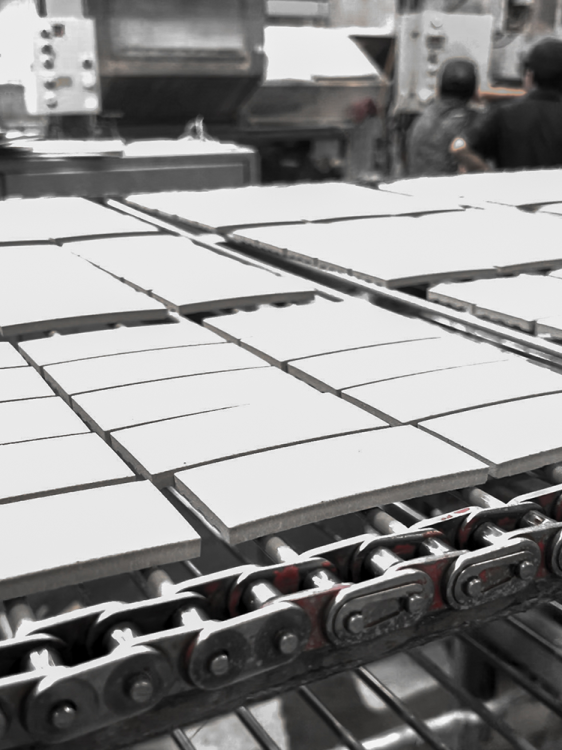ReservationSearch and reserve rooms
Click here to confirm, change or cancel your reservation
Shinkansen accommodation plan
提携法人専用予約
2024.02.28
"Earth and Water" Primitive materials create beautiful details. The appeal and potential of mosaic tiles

Gifu Prefecture has long been famous as a producer of pottery. Among them, the pottery made in the Tono area of Tajimi, Toki, and Mizunami is called "Mino ware" and has a history of over 1,300 years. We visited Nitto Seito, which has been making Mino ware tiles for over 70 years in this pottery town, and the Mosaic Tile Museum, which is famous as a photogenic spot where you can rediscover the charm of tiles.
The walls and toilets of public baths are disappearing in Japan, but are considered works of art overseas.

Mosaic Tile Museum Exhibition Room
There are many different types of tiles, and tiles with a surface area of 50cm2 or less are called mosaic tiles. Tajimi boasts the largest production of mosaic tiles in Japan. Because they are small, they are highly regarded for their ease of installation, which allows them to be used on tightly curved surfaces, and their customizability, which allows for free combinations of color, shape, and size. In Showa-era architecture, mosaic tiles were popular as a building material for areas around water, such as the Mt. Fuji painted on the walls of public baths, kitchens, and toilets. However, as new building materials emerge one after another, many mosaic tiles are being discarded along with old houses.
Meanwhile, if we look overseas, we can still see them in various places. For example, mosaic tiles are widely used in Park Guell, designed by Antoni Gaudi, the famous architect of the Sagrada Familia, and in Islamic mosques. In many foreign countries, where they are often used as art pieces, religious architecture, and in places that move people's hearts, they continue to be valued as artistic expression and building materials.
The difficulty of creating something the same way. The relationship between the whole and the parts in design

A mosaic tile object stretching towards the sky
It is important that each color is a set hue in order to create the overall design of a collection of mosaic tiles. If there is a range of colors within one color, it will be impossible to create a delicate gradation when the tiles are pasted together. Different colors that should be next to each other will look the same, and adjacent colors will look different, which will prevent the overall design from coming together.
The most difficult process in expressing color is the firing process. Even if the temperature setting on the machine is the same, the temperature inside the kiln can change depending on the outside air temperature and humidity. Even in the same kiln, the fire circulates differently depending on the location. Even in the same kiln, the color can change significantly depending on the "kiln atmosphere" caused by partial differences in the amount of oxygen. It is necessary to control a variety of conditions.
At Nitto Seito, we take great care to keep the temperature and environment of the kiln consistent and uniform in order to constantly control the color. Nitto Seito produces 120 types of mosaic tiles in over 5,000 colors. The careful management of each product enhances the overall design of the mosaic tiles.

A manufacturing scene where neatly arranged mosaic tiles flow along a conveyor belt
We are entering an era where every single tiny piece is given attention. Women who like small and cute things are also paying attention to them as DIY materials.

Swan Tile Cafe, where accessories made with mosaic tiles are on display
Nitto Seito operates the Swan Tile Cafe to promote the new appeal of tiles. You can dine in a retro-modern space surrounded by mosaic tiles. Inside the cafe, tools used in the pottery industry are used as lighting, creating a display unique to a ceramics manufacturer. You can take home a mosaic tile chopstick rest as a souvenir. In the workshop next door, you can also experience making miscellaneous goods using mosaic tiles.
In 2016, the opening of the Mosaic Tile Museum drew a lot of attention to Tajimi, even from people who aren't interested in tiles. The exterior, designed by architect Terunobu Fujimori, is modeled after a "clay mountain," and is a mysterious space that combines nostalgia and avant-garde elements. Inside the museum, tiles of great historical value that were about to be discarded are on display. Works by tile artists who are no longer in business are also on display here.
At the Mosaic Tile Museum, you can experience making tiles just like at the Swan Tile Cafe, and you can also purchase mosaic tiles as DIY materials. Because the materials are so fine, anyone can arrange them freely, and they are gaining new attention as a material for everyday items and wearable accessories.
Changing with the times and continuing to transmit information, the Mosaic Tile Museum and Swan Tile Cafe are fascinating spaces that will get your heart pumping just by looking at them.
Mosaic Tile Museum
電話:0572-43-5101
Address: 2082-5 Kasaharacho, Tajimi City, Gifu Prefecture, 507-0901
Access: Get off at JR "Tajimi Station", Totetsu Bus Kasahara Line "Mosaic Tile Museum"
HP: https://www.mosaictile-museum.jp/
SNS: https://www.instagram.com/mosaictile.museum/
Nitto Ceramics Co., Ltd.
電話:0572-27-2155
Address: 1-125 Meiwacho, Tajimi City, Gifu Prefecture, 507-0072
Access: From the Tajimi IC on the Chuo Expressway, take National Route 248 towards Kani/Minokamo for 1 km, then turn right at the Meiwacho intersection.
HP: http://www.nittoseitosho.co.jp/
SNS: https://www.instagram.com/swantile_tokyo
Tajimi Tile Cafe | Swan Tile Cafe
電話:0572-26-9516
Address: 10-6-15 Asahigaoka, Tajimi City, Gifu Prefecture (within Mino ware wholesale complex)
Access: 7 minutes from Tajimi IC on the Chuo Expressway. Parking available.
Get off at JR Chuo Line "Tajimi Station" From the north exit bus stop, take the "Sakuragaoka bound" bus for about 15 minutes → Get off at "Minoyaki Oroshi Danchi Mae" and walk for 5 minutes




